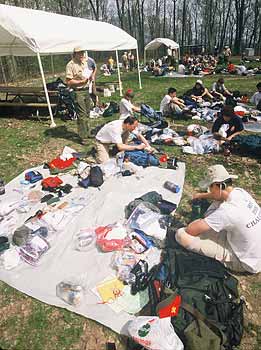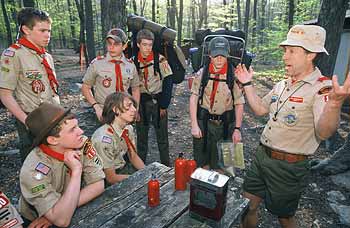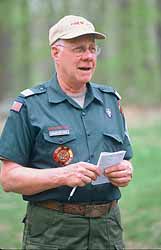Getting Ready For High Adventure
By Tom Dwyer
Photographs By Bob Krist
A council's weekend shakedown helps Scouts and leaders sharpen outdoor skills (and gain confidence) for the rigors of Philmont or any other wilderness outing.
Last year on May Day, 200 Scouts and adults arrived at Camp Wheeler in Stanhope, N.J., to cap preparations for their forthcoming treks.
Subdivided, the group—all from Patriots' Path Council in New Jersey—made up 18 crews soon to depart for Philmont Scout Ranch, the BSA's national high adventure base in New Mexico.
Everyone had spent the past eight months getting ready for the excitement that awaited them 2,000 miles away. This weekend, they would rehearse the 10-day treks that lay ahead.
 "Shakedown Mesa" is where Scouts decide what gear goes and what gets left behind. |
Dubbed the "Watchu Mountain Adventure," the program provides final training in important outdoor skills, answers questions, and, in some cases, removes apprehension about the challenge of a Philmont mountain trek.
Headed by "Chief Watchu"—also known as veteran Philmont staff member Dave Setzer (see sidebar)—the course is run by a volunteer staff of 30 at Camp Wheeler, located in Mount Allamuchy Scout Reservation.
It began in 1997 when council program director Bob Morris, disappointed by a low turnout at a high adventure preview, asked Setzer to figure out why more Scouts weren't signing up.
The real question, Setzer determined, was: "Why aren't Scoutmasters more enthused about high adventure opportunities like Philmont?"
The answers involved time, money, knowledge, family and work commitments, and liability issues. But also on the list: Many Scoutmasters feared they weren't up to the task—mentally or physically—of leading a mountain trek.
So the council designed a shakedown weekend that promised to prepare crews with wilderness hiking and camping skills, and boost their leaders' confidence and enthusiasm.
A taste of Philmont
To familiarize participants with their trek destination, the Watchu staff renamed Camp Wheeler facilities with the names of actual Philmont locations and landmarks.
This is why, at midmorning, Philmont Crew 711G8 was being issued its weekend grub outside "Cimarroncito Lodge" as crew members prepared to set out on an eight-mile mountain hike.
"To get to my rain gear, I'm going to have to eat my way through all this food," observed Life Scout Grif Dudley of Troop 351, Basking Ridge, N.J. His backpack was now bulging with food.
In fact, Grif had humorously revealed a gap in the crew's preparation for Philmont: In packing their backpacks they would need to leave room for additional necessities (like food) to be issued to them at Philmont's base camp.
'Find the gaps'
This type of "teachable moment" was what Dave (Chief Watchu) Setzer asked his staff to look for during a final pep talk in the camp office.
"Our mission this weekend," he reminded them, "is to 'find the gaps.' Watchu is a chance for crews to discover where they're not prepared. Before they leave Sunday, every gap they need to fill should be in their notebooks," he said, holding up a green pocket notebook.
Ten minutes before their 5 p.m. sign-in, Scouts from Troop 150, Bernardsville, N.J. (who formed Philmont Crew 630H4), were ready to go, backpacks lined up against a budding maple tree.
Program staffer Debbie Wickham peppered the acting crew chief, Life Scout Scott Rand, and adult adviser Gary Curl with questions. Medical records? Right here. Fees paid? 100 percent. Everyone here? All 12 present and accounted for. Permission slips? Got 'em!
The six hours between check-in and lights-out on Friday filled up quickly with youth and adviser briefings, an opening campfire, and a unit leader and staff cracker barrel meeting.
Leaders took notes at the cracker barrel about securing water, fuel, and food for the weekend. They heard about the caterpillar, a hiking method that allows crew members to rest while keeping them together on the trail. The meeting ended with 15 minutes of reflection on "how we did today" and "how we might do it differently tomorrow."
This wasn't the first communication with the adult leaders. Since September, crew leaders had received information and guidance via numerous Watchu Grams, delivered by e-mail over the Watchu Network.
The leaders filed helpful information in a two-inch-thick crew guidebook. Their knowledge and confidence grew with tips ("Crew chief selection is the responsibility of the youth"), questions ("Why is Youth Protection required for Scouts?"), and reminders ("Next adviser briefing, 7:30, Wednesday").
Watchu Grams also included news and information on crew overnights, family gatherings, crew conditioning, paperwork, gear preparation, T-shirt order forms, trek route selection, and Colorado tour information.
Beyond skills
Brushing up his wilderness outdoor skills helped Life Scout Christopher Elam, of Troop 49, Milton, N.J., recognize that "going from troop camping to Philmont-type wilderness camping is a tremendous leap."
 Rich Rosencrans of Troop 17, from Denville, N.J., teaches Scouts how to safely pack and handle fuel for camp stoves. |
Scouter Tim Seaton also appreciated the training. Unlike Christopher, Seaton had no Watchu-type preparation before his first Philmont trek in 1961. Now a veteran of two Watchu weekends, he served as Troop 351's crew adviser for 2004.
"For some of the boys, this is the first time they have really felt the weight in their packs," Seaton noted. "Now, they'll have some time to make changes in what they bring and what they leave out."
After finishing their training hikes, troops gathered in the evening at Cimarroncito Lodge for a multimedia orientation program designed to generate even more excitement about Philmont.
The hectic pace had taken some spring out of their step but not the buzz from their spirit.
"Our Watchu experience has shown that we are very good hikers," reported Joel Read, assistant Scoutmaster of Troop 121 and adviser to Philmont Crew 711G3. "At the same time we've discovered we need to better define the roles of our crew members."
Later, crews met with experienced Philmont hikers like Rich Olson, a member of the council high adventure committee, who previewed the trek each crew would take in New Mexico.
Crew members were tired, but their attention didn't waiver. On a Philmont map, Olson pointed out water, food pickup, and a "decision point" where "you either check out Crooked Creek or deadhead into Porcupine."
Added impact
Crews returning from a Philmont trek praise the Watchu weekend.
Eagle Scout Rob Shick, chief ranger for the weekend, trekked Philmont two years ago. "Because of Watchu, we were able to get out on the trail early, ahead of the hot sun and other crews."
Watchu can also convince a Scout he is not up to the rigors of a trek, Rob said, recalling one Scout who realized that Philmont was not for him.
For others, however, "it's sort of the cross-over into adulthood," Rob observed. "And, it strengthens our determination to stay in Scouting."
There's also evidence that the Watchu program goes beyond boosting Philmont participation.
"What we learned at Watchu translates into our troop's high adventure program," said Troop 73's Tim Avis, adult adviser to Philmont Crew 711G7.
His troop has been to Philmont twice, hiked Vermont's Long Trail, and canoed in the Adirondack Mountains.
And Scouter Tom Wills, veteran of eight Philmont expeditions, said the impact of a high adventure trek goes beyond that one experience.
"I've seen 14-year-old Scouts whose interest in Scouting was waning [before a trek] go on to become Eagle Scouts."
And the Watchu program has also increased high adventure participation in the Patriots' Path Council.
Last spring council director of program services Bob Morris held another high adventure open house, this one with information about the 2005 National Scout Jamboree, Northern Tier High Adventure Bases, Florida Sea Base, and Philmont Scout Ranch.
"Spaces for 2005 sold out in one night," Morris reported. "And two crews requested information for 2006."
Freelance writer Tom Dwyer lives in Manlius, N.Y.
Why Watchu?
The Patriots' Path Council calls its Philmont high adventure shakedown weekend "Watchu." "We live in the land of the Lenni Lenape Indians," wrote Dave Setzer (who heads the program as "Chief Watchu") in an article for the Philmont Staff Association. The name hails from an "unsubstantiated folk tale" that describes Watchu as a tribal leader responsible for the development of individual members of the tribe. "We chose the Watchu Mountain Adventure and Chief Watchu to represent what we are all about," said Setzer. "Personal development, adventure, fun, and excitement are the focus of our council's teenage Scouting experience." —T.D. |
May - June 2005 Table of Contents
Copyright © 2005 by the Boy Scouts of America. All rights thereunder reserved; anything appearing in Scouting magazine or on its Web site may not be reprinted either wholly or in part without written permission. Because of freedom given authors, opinions may not reflect official concurrence.
